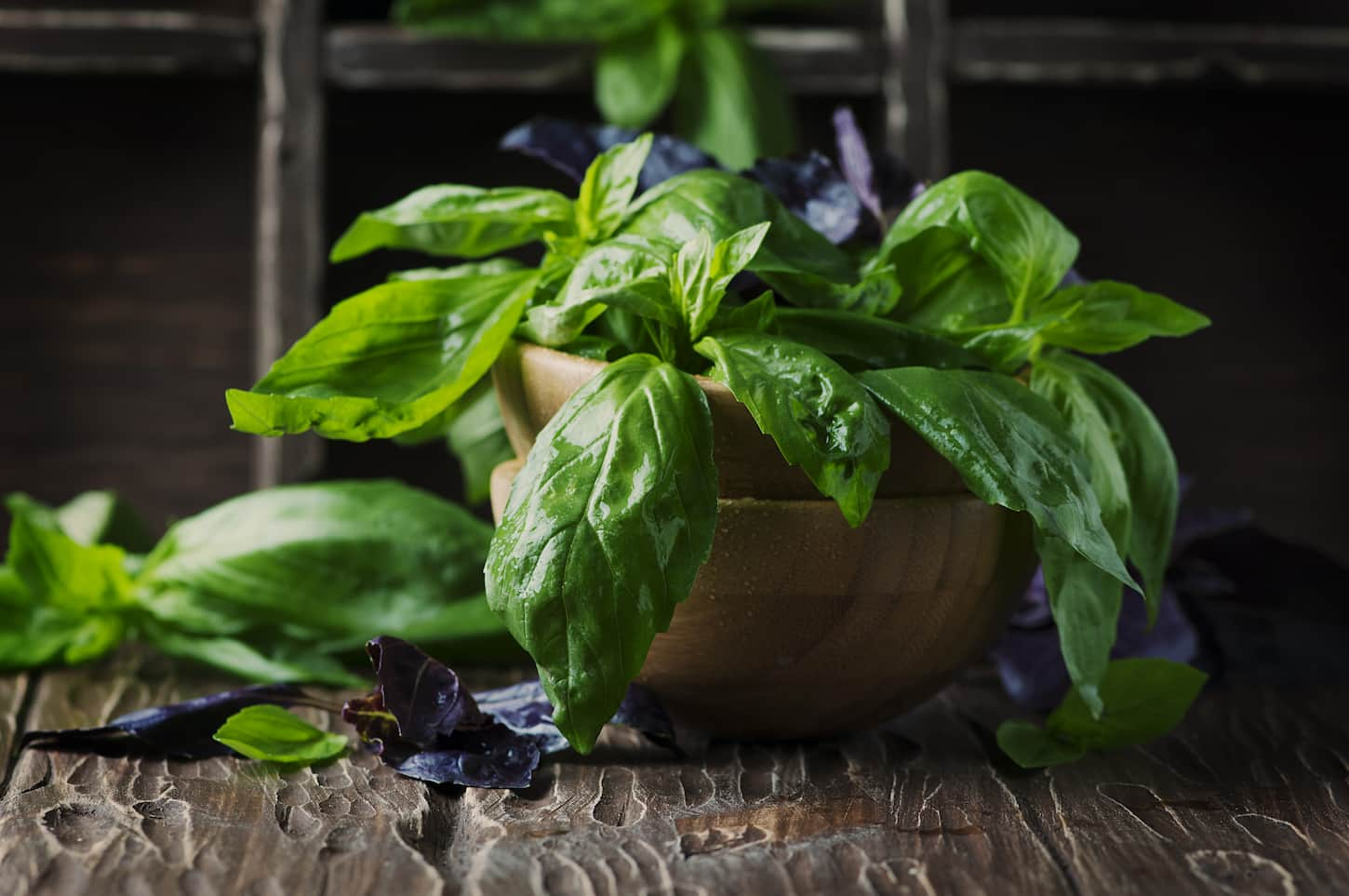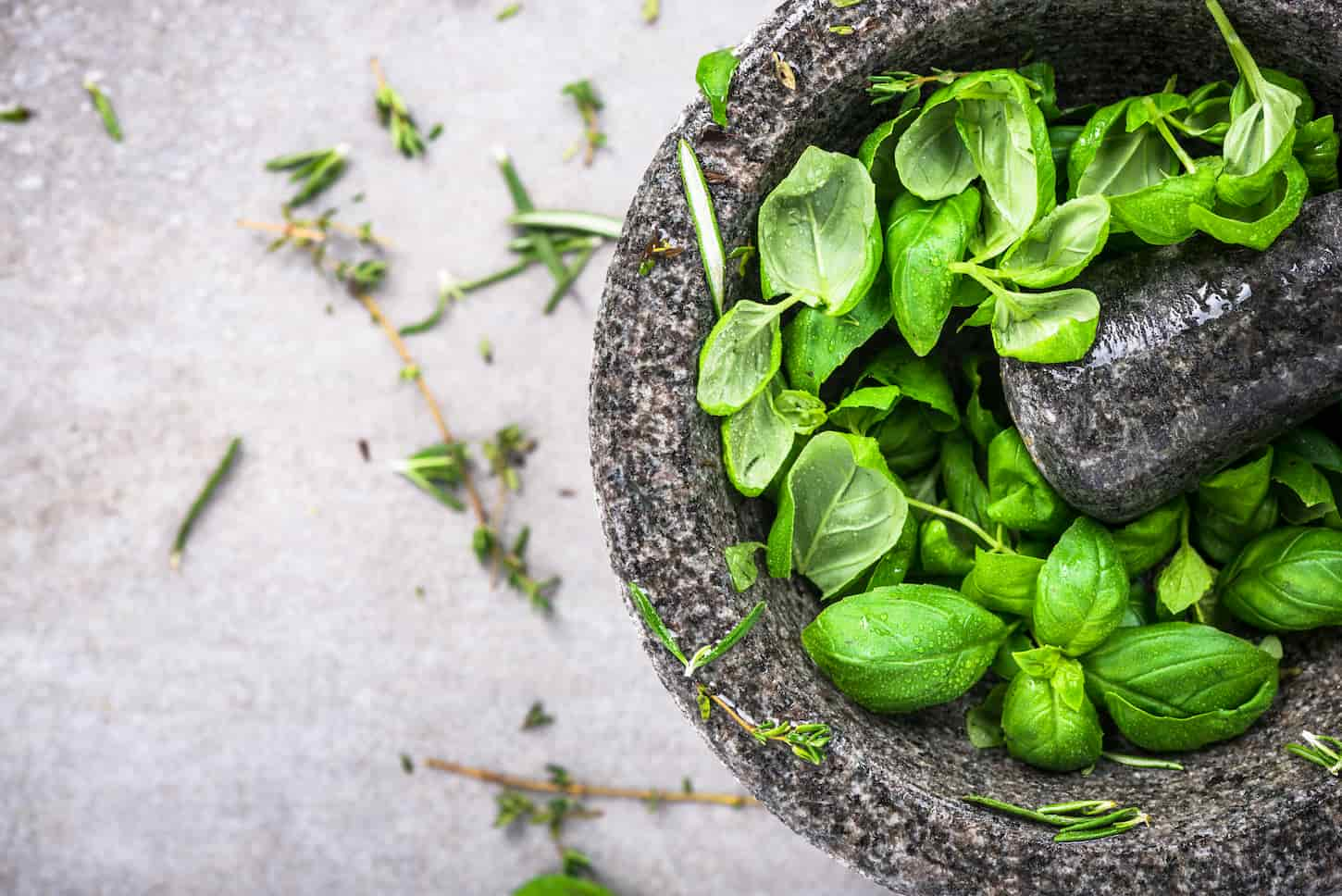Basil is a member of the mint family and is used worldwide. Popularized in the Mediterranean, the herb originated in India and was advanced by ancient routes revolving around the spice trade. It’s kind of some cool history, but the history doesn’t much matter when you’re wondering why the leaves on your basil plant are turning white.
Basil leaves turn white due to nutrient deficiency, watering issues, extreme temperature fluctuations, overexposure to sunlight, or an infection (either of disease or pests). If the issue is quickly diagnosed and addressed, most basil can recover just fine.
Basil is beloved by the gardening community and culinary arts alike as an herb that provides many vitamins and minerals beneficial to overall health is beginner-friendly and grows quickly when nurtured under the right conditions. So, let’s talk about how we can help our basil grow without any icky white spots.

Why Basil Leaves Turn White
Basil, though relatively easy to grow, can be affected by overexposure to the sun, insects and other pests, temperature fluctuation, fungal infections, salt build-up, soil, overwatering, underwatering, and inadequate light.
Reason #1: Overexposure to the sun
Though basil thrives in sunlight, overexposure to the sun can cause white spotting on the leaves. This is due to the deterioration of chlorophyll in the plant.
Reason #2: Insects and pests
Insects and pests can take a toll on any plant. It is likely if you have done any sort of gardening, you have run into unwanted visitors. Insects and pests can infiltrate your basil plants, leaving them deprived of the water and nutrients needed to thrive. Common culprits are nematodes, beetles, slugs, whiteflies, squirrels, aphids, and deer.
Reason #3: Temperature fluctuation
As with many plants, the temperature is an important component in maintaining growth and sustenance. Since it originated in warmer climates, basil thrives at an average temperature of 50-80 degrees Fahrenheit with 40-60% humidity. Fluctuation of the temperature can cause white spotting on the leaves and be detrimental to the overall health of the plant.
Reason #4: Fungal infections
Fungi such as downy mildew and fusarium wilt are two common infections you may encounter when growing basil. These are characterized by spotting and discoloration of the plant, as well as fuzz and unwelcome growth on the plant.
Reason #5: Salt build-up
Salt building up causes water retention and dehydration in basil. Salt build-up from fertilizer or compromised water quality is common in attributing to lack of nutrients and white spots on basil plants.
Reason #6: Soil issues
The correct soil for growing a basil plant is one with a well-balanced pH value, air circulation, and adequate moisture drainage. Using the wrong type of soil can cause nutrient deficiency, rotting, and discoloration of the leaves.
Reason #7: Watering issues
With basil, getting the right amount of water is key. Both overwatering and underwatering can cause issues. The nice thing, though, is that once you realize that basil has a moderate love of water, it’s a lot easier to keep the watering level in that happy medium.
Overwatering
Overwatering basil can damage the root system, causing a lack of food and water for the plant. Root rot and white or yellow leaves occur when plants are overwatered, preventing essential nutrients from reaching where they need to go.
Underwatering
When basil is under-watered, it loses its ability to receive nutrients, hydration, and food from its roots. This often results in the discoloration of leaves and deterioration of the herb as a whole.
Reason #8: Inappropriate levels of light
Basil needs approximately six hours of sunlight a day, or ten hours of fluorescent plant light to thrive. Inadequate amounts of light can cause a deficiency in chlorophyll, resulting in color fading from the leaves.
Too much sun can also sunburn the plant, damaging the chlorophyll cells and leaving white spots on the damaged areas of the leaf.

How to Avoid White Leaves in Basil Plants
With so many components affecting basil leaves’ makeup, you may face white leaves at some point during your gardening journey. Here are just a few ways you can keep your herbs happy and avoid white leaves.
Remember, too, that this is all about finding that happy medium for basil plants. So you will need to do some experimenting to get things “just right.”
Tip #1: Monitor how much light the plant gets
Keeping basil near a sunny window, or under a fluorescent plant, the lamp will help it get the amount of light it needs to flourish. Basil plants love the light, and six to eight hours is ideal.
Too much sun can damage the plant, too. So don’t keep it in direct sunlight for more than 10-12 hours max if you can avoid it. Sunburn is a very real possibility. Make use of plant shades or cover crops to provide some shade if you can.
Tip #2: Water basil carefully (and monitor soil moisture levels)
Basil is a plant that enjoys water. Watering once a week with about an inch of water is adequate. If you have it growing in a container, rather than on the ground, it may require more water. Just be sure you are careful not to overwater it, as this could result in root rot.
Tip #3: Keep the soil healthy
Nutrient-rich, moist, pH-balanced soil has many positive benefits on basil plants that help ward off pesky white leaves. Use organic compost to boost your soil. Measure the pH balance with regular tests.
If your soil is super clay-heavy, consider amending the soil and tilling it short-term to improve it. Or use various permaculture techniques if you want to build a better soil ecosystem on top of whatever soil you’ve already got.
Tip #4: Manage pests
Take precautions against pests to keep your basil plants alive and blooming.
If you’re on board with using pesticides, consider using those as appropriate.
Or, if you are personally against using chemical pesticides, then use home remedies such as diluted soapy water, or diluted apple cider vinegar can aid in your fight against pests and insects.
Don’t forget to consider larger “pests,” too. Deer, squirrels, and other small animals can be deterred by wire fencing or repellant.
Personally, we love letting our chickens roam in our garden. We put up chicken wire to protect the plants that need protecting, but then our chickens help manage the pest load in our garden. And they fertilize as they go, which is a nice perk!

Frequently Asked Questions about Basil Leaf Color
Here are some answers to commonly asked questions about basil leaf color. Our goal is to provide the best, most thorough answers. So, if we missed your question, would you please use our contact us page and let us know what your question is? That way, we can get you an answer and update this article.
Why does my basil plant have white leaves?
Recognizing signs of distress or sickness in your plants is an important part of cultivating your green thumb. You might notice your basil leaves turning white. This can mean a multitude of things, but most commonly points to undesirable growing conditions or infection for your basil plant.
Why are my basil leaves turning silver?
Basil leaves turn silver due to nutrient deficiency, overwatering, and fungal infections. Pruning, providing good soil, and the right amount of water can aid in preventing this from happening.
Why is my basil losing color?
Basil tends to lose color due to overexposure to sunlight, resulting in the lack of chlorophyll in the leaves of the plant when the photosynthesis cells break down. Basil plants that lose color can be restored by adjusting the amount of light received.
Why is my basil plant pale?
Paleness in basil plants can be attributed to root rot, overwatering, and not receiving enough nutrients. Over time, good soil and filtered water can aid in bringing back the luscious green color of basil.
Next Steps
Basil is an herb valued for its nutritional properties, health benefits, and culinary flavor. In some instances, you may encounter a lack of color in the leaves, pointing to a multitude of issues and sicknesses your plant is affected by. Taking precautionary measures for preventing these issues is the best way to ensure the growth of a happy and healthy basil plant.
That way, you’ll be able to store your basil for year-long use. Or you can store some for use while still growing plenty of basil year-round by moving the pot indoors. Either way, make sure you’re ready to freeze-dry anything by reading this article I wrote next: 17 Reasons You Need a Freeze-Dryer.
Resources
Learning from your own experience is essential, but learning from others is also intelligent. These are the sources used in this article and our research to be more informed as homesteaders.
- “Basil.” University of Maryland Extension, 15 July 2021, extension.umd.edu/resource/basil.
- “Basil Garden | Snohomish County | Washington State University.” Washington State University, 27 May 2020, extension.wsu.edu/snohomish/basil-garden.
- Pearson, Lindsay, and Dan Drost. “Basil in the Garden.” University of Utah Extension, May 2020, digitalcommons.usu.edu/cgi/viewcontent.cgi?referer=&httpsredir=1&article=1270&context=extension_curall.

After I remove the white leaves from the basil plant is is safe to grow it and eat it
Should I cut the white leaves off my basil plant
I’d cut them off, yes. They aren’t healthy, and they won’t taste right. So why not help the plant focus on recovering and growing healthy leaves – that you can eat and enjoy?
Yup! I’d keep an eye on the plant, though, to make sure whatever was causing the white leaves has been adequately resolved.